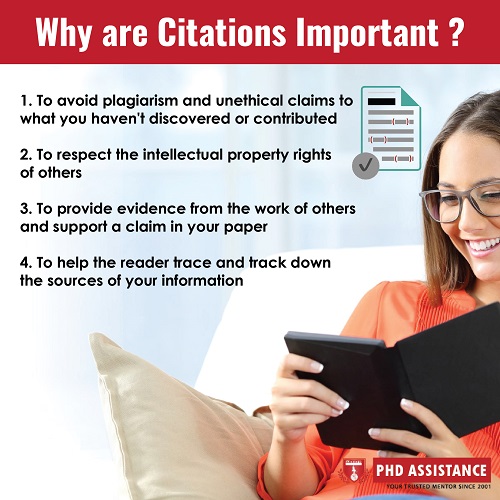How to correctly cite sources in research paper?
Introduction
Academic writing necessitates the use of citations. You should include a citation that gives attribution to the respective author if you utilize ideas and knowledge from a source such as a book, article, or web page. To avoid plagiarism, a citation is essential. There are many different referencing styles, each with its own set of formatting criteria. In scholarly work, a citation style is a set of standards for citing sources. Official guidebooks with descriptions, illustrations, and directions are frequently produced with citation style requirements. The following are the most prevalent citation styles:
- In the humanities, MLA style is used (literature or languages)
- In the social sciences, the APA style is used (psychology or education)
- In history, Chicago notes and bibliographies are used.
- In the sciences, the author-date format is used.

When to cite sources
In all kinds of scholarly texts, references are mandatory. You must cite a reference every whenever you use it to expand on ideas, summarize facts, argue the case, or offer evidence. You have to cite sources when you do the following:
- Quote or rephrase the actual document to link to a source:
- Take a brief piece of text verbatim and place it within quotation marks to quote a resource.
- Put the material around your own terms to summarize a source.
To avoid plagiarism, whether you cite or rephrase, you should always add a citation. Referencing also helps your audience to locate the primary author for themselves, enhancing the credibility of your article. You can trust us for PhD Dissertation Writing Help.
Remember to reference any other materials you utilize for concepts, illustrations, or proofs, in addition to scholarly articles like books and journals. Webpages, YouTube clips, reference books, seminars, and online media comments all fall under this category.
Which citation style to use
Check the requirements first because many university departments and scholarly articles need a citation style. You must choose a citation style and utilize it uniformly through your paper if no reference style is mentioned.
Your best option is determined by your subject and specialty. In the social sciences, APA is the most widely used style, whereas in the humanities, MLA is the most widely used style. Other fields, such as medicine or engineering, have their own distinct styles.
You can find out what style your professor uses by asking them or reading previous papers in your field. PhD Assistance experts has experience in handling to Publish the journal papers in all research subjects with assured 2:1 distinction. Talk to Experts Now
In-text citations and full references
There are two fundamental components to every source citation:
- Next to the necessary material, include a brief in-text citation.
- A complete reference that includes all of the information needed to locate the original source.
Citations in the text: In-text citations are usually written in parenthesis and include the author’s last name as well as a year or page number (depending on the citation style). You can trust us for Future PhD Research Services. Footnotes, endnotes, or bracketed numerals that match reference data are used in some styles. Each citation style has its own set of criteria for citing:
- sources with numerous authors
- sources without a name for the author
- sources with an unclear publication date
- sources that don’t have page numbers
- a single author’s many sources
References, also known as Works Cited or Bibliography, are frequently listed at the end of a document.
The author, title, and publication date of the source are always included in full references. They also contain additional information that aids in the identification of the source. Contact PhD Assistance for reference collection and Future Research work.
A reference’s specific format is determined by the type of source. A book reference, for example, includes the publisher and, on occasion, the edition, whereas a journal article reference includes the volume and issue numbers as well as the page range where the article occurs.
Using a citation generator
It might be tough to get every detail exactly because each style has so many little variances. Using a citation generator is the simplest method. The generator will automatically generate an in-text reference and reference entry in the correct format if you use a URL or DOI, or if you manually enter the resource details. You can save your list of references as you go along and then download it after you’re through.
Checking your citations
A plagiarism checker ensures that you’ve included citations where they’re required, whereas a citation checker ensures that your citations are properly formatted.
Conclusion
It is critical to correctly cite sources in order to avoid plagiarism in your content. Plagiarism is more than merely copying and pasting the words of another author.
Reference
- VanScoy, A., Julien, H., & Harding, A. (2022). “Like Putting Broccoli in a Quiche”: Instructors Talk about Incorporating Theory into Reference Courses. Journal of Education for Library and Information Science, e20210022.
- Reed, M., Kinder, D., & Farnum, C. (2022). Collaboration between librarians and teaching faculty to teach information literacy at one Ontario university: Experiences and outcomes. Journal of information literacy, 1(3), 29-46.
- Dwivedi, Y. K., Hughes, L., Cheung, C. M., Conboy, K., Duan, Y., Dubey, R., … & Viglia, G. (2022). How to develop a quality research article and avoid a journal desk rejection. International Journal of Information Management, 62, 102426.



